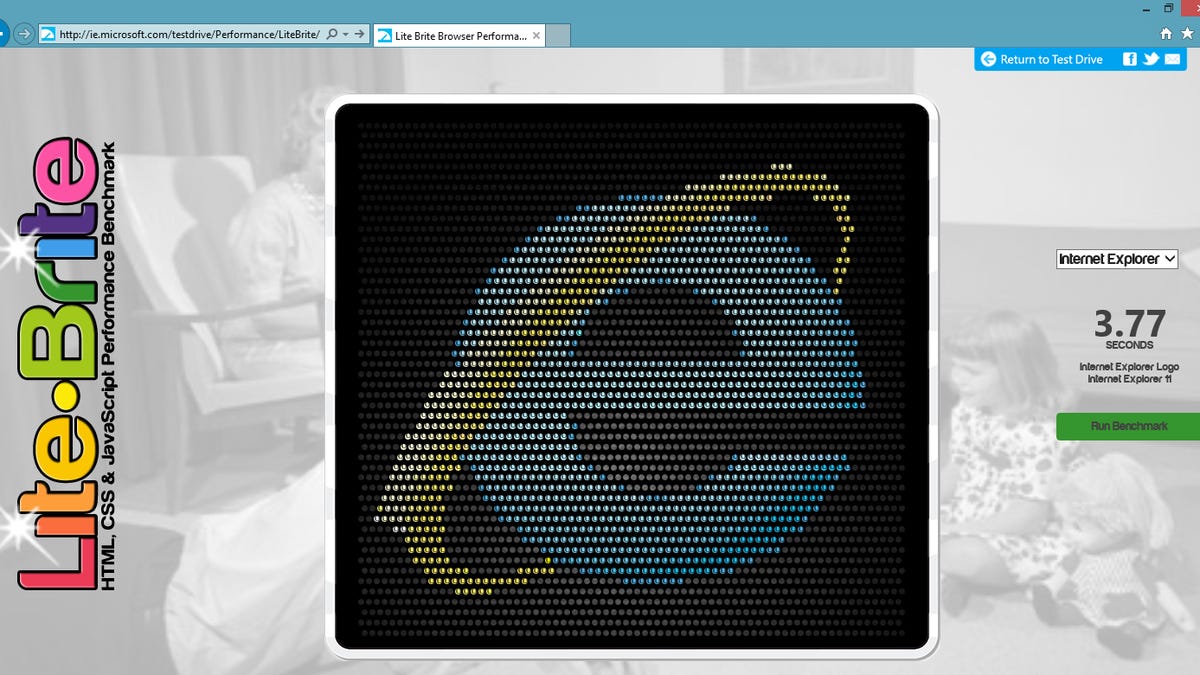Microsoft readies IE 11 for Windows 7, too
Internet Explorer 11 ships by default in Windows 8.1, and a developer preview of the browser for Windows 7 confirms that the older OS won't be left behind -- for now.

Browser aficionados and haters alike will be overjoyed that Microsoft is keeping its promise to keep the new Internet Explorer up-to-date on Windows 7 as well as Windows 8.
The Internet Explorer 11 Developer's Preview for Windows 7, which debuted on Thursday, introduces the most of the new features and functionality of the Windows 8.1 default browser.
Roger Capriotti, Microsoft's marketing director for Internet Explorer, said that, like IE 10 for Windows 7, IE 11 won't have the modern interface, but it will have performance benefits.
"We're faster than the folks at Chrome or the folks at Firefox," he said. "We've got better CPU [processing times], better usage, and better load time overall."
In addition to usual pitch of improved overall performance, the specifics of the Windows 7 IE 11 Developer's Preview include updated standards support and overhauled developer tools.
Repeating a talking point that's been at the forefront of Microsoft's campaign to revitalize its previously-moribund browser, Capriotti said that the team building IE wants developers "to spend more time developing and less time on standards."
Most of the backend changes to IE 11 for Windows 7 are in the Windows 8.1 version. These include several firsts that result in faster site loading, according to Microsoft.
The browser is the first to implement the W3C Resource Priorities standard, so that developers can tell the browser which parts of a page to load first; it's the first to render text on the graphics processing unit (GPU), to more directly accelerate page loading; and it's the first to natively decodes JPG images in real-time on the GPU; which reduces overall battery drain as well as speeds up site loading.
IE 11 also includes support for WebGL, and it supports the security- and speed-focused SPDY protocol, which originated at Google. These are notable because both previously had been sniffed at by Microsoft. The ECMAScript 6 standard scripting language is supported, too, as is more "just-in-time" compiler in the browser's JavaScript engine, Chakra.
And to get developers to stand up and take notice, the Microsoft team has overhauled its "F12" developer tools. There's a new memory management tool that shows in cleanly-designed, real-time charts memory spikes and other problems.
A new emulation tool allows the developer to mimic how their site will look on screen sizes for different devices. It also has a geolocation tool for region-specific debugging.
The new User Interface Responsiveness tool isn't not working in the current developer's preview, but Capriotti says it will ship in the final version. It uses more graphics than before to show developers how a site is behaving, with color-coded problems areas and detailed, real-time charts.
To sweeten the deal, the company has revamped its debugging modern.IE Web site, offered a 25 percent discount on Parallels Desktop 8 for Mac, and made virtual machines available for Internet Explorer 11.
Basically, Internet Explorer 11 is a highly competitive browser. Or at least, that's Microsoft's plan. But the competition updates on a six-week release cycle, and Capriotti wouldn't say when IE 11 would be ready for the public. If it follows the release pattern of IE 10 for Windows 7, it will be around four months after IE 11 arrives with Windows 8.1.
Besides swimming upstream against years of negative marks for IE, Microsoft struggles with rapid standards implementation. Part of that is market dynamics. According to NetApplications' market share statistics, IE still has more people using it than Chrome and Firefox combined, and making changes on a six-week release cycle as Google and Mozilla do would likely anger customers.
However, that means that those browsers, which are developed in a far more open manner than IE, are able to implement new technologies and standards much more rapidly than IE. Capriotti wouldn't confirm any IE development on the latest in browser tech such as ASM.js, which Firefox has and Chrome is looking at adopting; or WebRTC, an HTML5-based real-time communications protocol that eliminates the need for plug-ins like Skype.
"There's this tension of what rapid release should be," he said. "Is it 6 weeks? Six months? We don't think it should be six years," he joked.
The truth is that all of Microsoft's Windows divisions are moving towards updating more rapidly than in the past, as Steve Ballmer said at the recent Build conference, and that includes Internet Explorer.
But while Microsoft is concerned with keeping Internet Explorer up with the Joneses, the Joneses -- mostly Chrome and even Firefox a bit as it moves into the mobile OS world -- are looking beyond the traditional markets.

